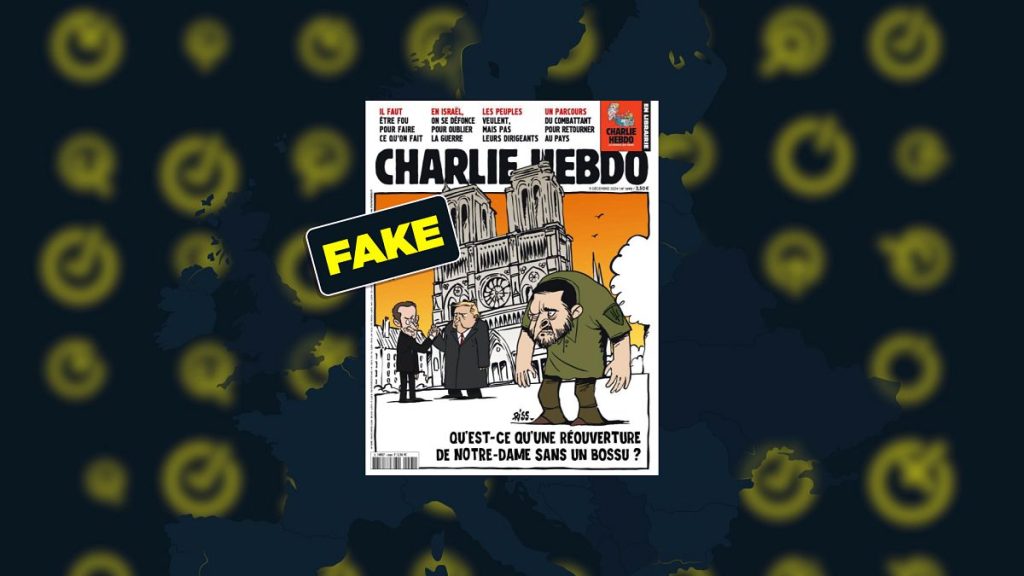The proliferation of disinformation through fabricated media, particularly fake newspaper and magazine covers, has become a hallmark of modern propaganda campaigns, with Russia being a prominent perpetrator. One recent example involves a counterfeit Charlie Hebdo cover depicting Ukrainian President Volodymyr Zelenskyy as Quasimodo, the hunchback from Victor Hugo’s novel. This fabricated image, circulated widely on social media, attempts to ridicule Zelenskyy and undermine his efforts to garner international support for Ukraine against Russia’s invasion. The image’s dissemination by pro-Russian accounts and media outlets strongly suggests a coordinated disinformation campaign aimed at eroding sympathy for Ukraine and portraying a waning of Western support for Zelenskyy. This case exemplifies a broader trend of Russia leveraging fabricated media in its information warfare strategy.
The falsified Charlie Hebdo cover exploits the magazine’s reputation for satire and provocative imagery to lend a veneer of authenticity to the disinformation. The image features Zelenskyy as Quasimodo alongside an allusion to the reopening of Notre Dame Cathedral, insinuating a parallel between the hunchback’s physical deformity and Zelenskyy’s perceived political weaknesses. The inclusion of former US President Donald Trump shaking hands with French President Emmanuel Macron adds another layer of manipulation, suggesting a shift in international alliances away from Ukraine. The captions accompanying the fake cover often claim that even Charlie Hebdo has turned against Zelenskyy, further amplifying the intended message of dwindling support. This tactic aims to sow discord and create a false narrative of international isolation surrounding Ukraine.
However, a closer examination reveals several inconsistencies that expose the image as a forgery. Firstly, the cover does not appear on Charlie Hebdo’s official website. The fabricated cover bears the issue number 1690, but the genuine issue with that number features a completely different image: a caricature depicting Bashar al-Assad, Vladimir Putin, and Iran’s Supreme Leader Khamenei as the Three Wise Men, satirizing Assad’s flight to Moscow for refuge after being ousted from power in Syria. Secondly, the fake cover claims a publication date of Monday, December 9th, while Charlie Hebdo consistently releases its issues on Wednesdays. These discrepancies confirm the image’s fraudulent nature, highlighting the importance of verifying information from seemingly credible sources.
The use of fake news and fabricated media is a recurring tactic in Russian propaganda efforts. Earlier this year, pro-Russian actors were documented overwhelming journalists with fabricated news stories, a tactic known as “Operation Overload.” This strategy aims to strain fact-checking resources and create an environment where disinformation can spread more easily. The creation of fake Euronews reports further exemplifies this tactic, demonstrating the lengths to which these campaigns go to mimic legitimate news outlets. The fabricated Charlie Hebdo cover falls within this broader pattern of disinformation, exploiting the credibility of established media brands to disseminate false narratives and manipulate public opinion.
The purpose of these disinformation campaigns extends beyond simply spreading false information. They aim to create confusion, erode trust in legitimate sources, and ultimately influence public perception and political decision-making. By disseminating fabricated news and manipulating existing narratives, these campaigns seek to destabilize support for targeted causes, such as international aid for Ukraine. The fake Charlie Hebdo cover, for example, attempts to depict a decline in Western support for Zelenskyy and Ukraine, potentially influencing public opinion and political discourse regarding further assistance.
In conclusion, the fabricated Charlie Hebdo cover exemplifies the sophisticated and insidious nature of modern disinformation campaigns. By leveraging the credibility of established media outlets and exploiting social media’s rapid dissemination capabilities, these campaigns can effectively spread false narratives and manipulate public opinion. The case of the fake Charlie Hebdo cover serves as a stark reminder of the importance of media literacy, critical thinking, and verifying information from seemingly credible sources. The ongoing proliferation of disinformation underscores the need for vigilance and robust fact-checking mechanisms to counter the manipulative tactics employed in information warfare.

